Table of contents
- Bimota YB8 in the youngtimer check Model type YB6 1000 to YB11
- Model history – YB6 1000 to YB11
- Market situation
- technology
- Bimota YB8 Furano
- Reinhold Kraft on Bimota YB8
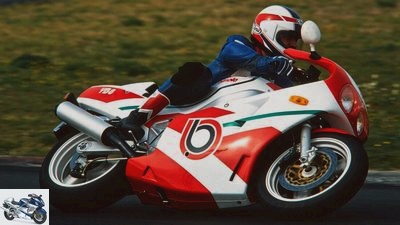
fac, Frank Herzog, Ralf Schneider, Achim Hartmann, MOTORRAD-Archiv, Yamaha, Reinhold Kraft
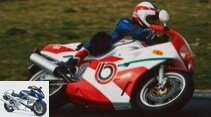
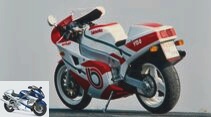
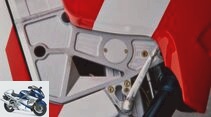
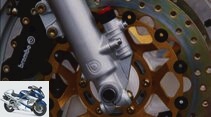
14th pictures
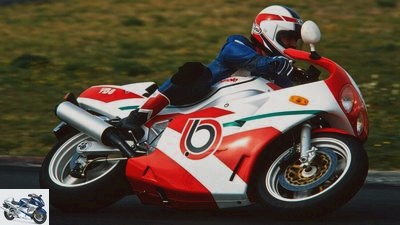
fac, Frank Herzog, Ralf Schneider, Achim Hartmann, MOTORRAD-Archiv, Yamaha, Reinhold Kraft
1/14
While Japanese manufacturers were still pondering the right concept for their super sports cars, the Italian luxury forge Bimota showed how it works.
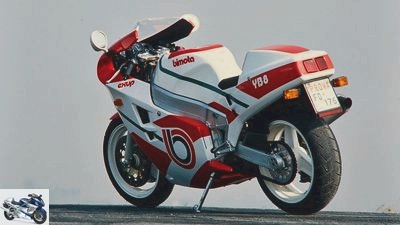
fac, Frank Herzog, Ralf Schneider, Achim Hartmann, MOTORRAD-Archiv, Yamaha, Reinhold Kraft
2/14
The aluminum frame Yamaha Bimotas with 1000 engines, which have only been built 2,105 times, are very seldom offered, and when they are, it is usually not in optimal condition.

fac, Frank Herzog, Ralf Schneider, Achim Hartmann, MOTORRAD-Archiv, Yamaha, Reinhold Kraft
3/14
Noble and expensive: The YB8 has swing arm bearings that are milled from solid.
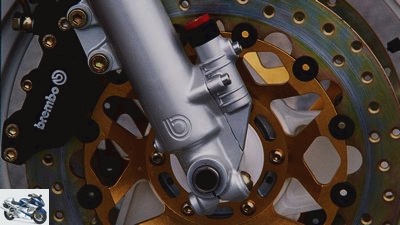
fac, Frank Herzog, Ralf Schneider, Achim Hartmann, MOTORRAD-Archiv, Yamaha, Reinhold Kraft
4/14
Floating Brembo discs and an adjustable Marzocchi fork work on the front wheel.
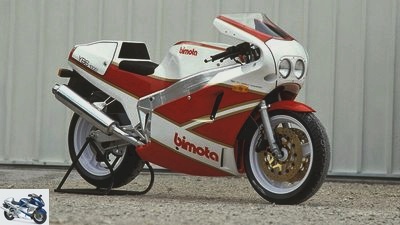
fac, Frank Herzog, Ralf Schneider, Achim Hartmann, MOTORRAD-Archiv, Yamaha, Reinhold Kraft
5/14
Bimota YB6 1000: The predecessor of the YB8 appeared in 1988 with the first Yamaha FZR 1000 engine (986 cm³). The look is still very much based on the superbike machine.
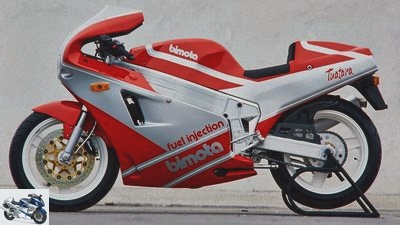
fac, Frank Herzog, Ralf Schneider, Achim Hartmann, MOTORRAD-Archiv, Yamaha, Reinhold Kraft
6/14
Bimota Tuatara: A noble version, built only 60 times, has been released since 1989. Anyone who owns one of the rare pieces should never sell it.
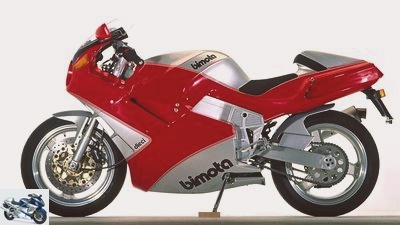
fac, Frank Herzog, Ralf Schneider, Achim Hartmann, MOTORRAD-Archiv, Yamaha, Reinhold Kraft
7/14
Bimota YB10 Dieci: Visually significantly redesigned model with a much more comfortable seating position and improved wind protection. By 1994, 224 copies had been built.
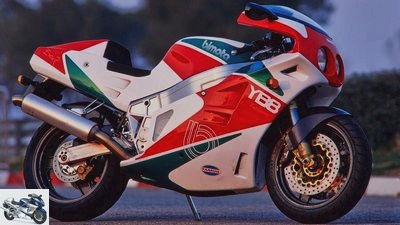
fac, Frank Herzog, Ralf Schneider, Achim Hartmann, MOTORRAD-Archiv, Yamaha, Reinhold Kraft
8/14
Bimota YB8 Evoluzione: In 1993 came the slightly revised version of the YB8 with injection and another change in optics. A nominal 164 hp and probably the best Bimota for everyday use. 169 copies were built.
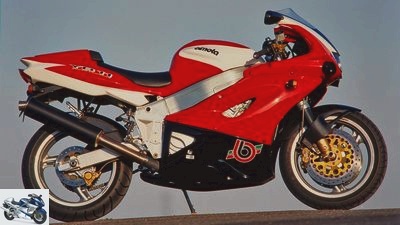
fac, Frank Herzog, Ralf Schneider, Achim Hartmann, MOTORRAD-Archiv, Yamaha, Reinhold Kraft
9/14
Bimota YB11: In 1996 the last 650 version of the Yamaha Bimota came with the Thunderace’s 145 hp engine. Chassis still based on the YB6. Improved seating position, good workmanship, dry weight 183 kg.
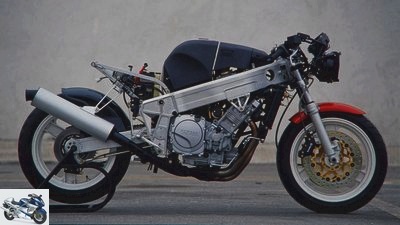
fac, Frank Herzog, Ralf Schneider, Achim Hartmann, MOTORRAD-Archiv, Yamaha, Reinhold Kraft
10/14
The chassis and engine work together optimally on the Bimota YB8.
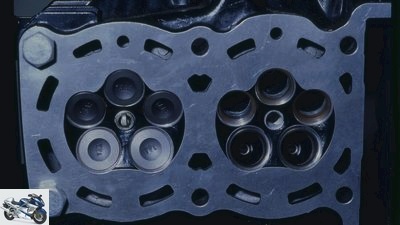
fac, Frank Herzog, Ralf Schneider, Achim Hartmann, MOTORRAD-Archiv, Yamaha, Reinhold Kraft
11/14
The five-valve head, with the cylinder bank inclined forwards, is part of modern Japanese design.
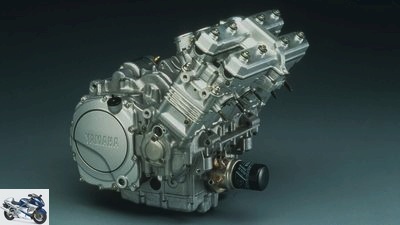
fac, Frank Herzog, Ralf Schneider, Achim Hartmann, MOTORRAD-Archiv, Yamaha, Reinhold Kraft
12/14
Stable and reliable even in the long-distance horsepower test: after 50,000 kilometers there were no serious defects in the five-valve four-cylinder engine of the Yamaha FZR 1000 EXUP. The forward-sloping bank of cylinders was unique.
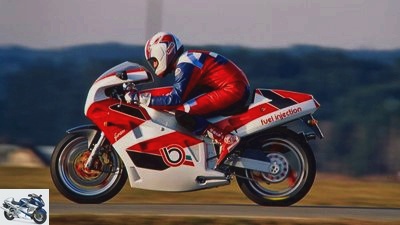
fac, Frank Herzog, Ralf Schneider, Achim Hartmann, MOTORRAD-Archiv, Yamaha, Reinhold Kraft
13/14
The best: Bimota YB8 Furano with injection and numerous carbon parts.
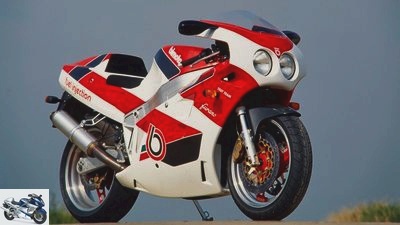
fac, Frank Herzog, Ralf Schneider, Achim Hartmann, MOTORRAD-Archiv, Yamaha, Reinhold Kraft
14/14
The YB8 Furano was only built 152 times.
motorcycles
Super athlete
Youngtimer check: Bimota YB8 (YB6 1000 to YB11)
Bimota YB8 in the youngtimer check
Model type YB6 1000 to YB11
Content of
While Japanese manufacturers were still pondering the right concept for their super sports bikes, the Italian luxury forge Bimota showed how it works: 1000 cc engine, slim superbike outfit, and the groundbreaking YB8 was ready.
Michael Pfeiffer
01/10/2021
Hockenheim, May 8, 1988: It is the first season of the newly founded Superbike World Championship, the best in the world in the four-stroke business give each other the edge with 750 cc four-cylinders. Up front two slim and pretty Italian women, driven by a certain Davide Tardozzi (yes, the one who recently boxed his colleague quite hard out of sheer joy in Spielberg) and Stephane Mertens. Bimota YB4 he was the name of the Italian lighters, powered by Yamaha’s FZ 750 five-valve inline four-cylinder, pepped up with an injection. Davide won both races, and the PS editor Pfeiffer was flat. Why does a small Italian shop manage to beat the four big Japanese? With a Japanese engine? That had to be due to the chassis. Or the injection. Or both.
Maximum stable chassis
The chassis was a sensational development by Federico Martini. The chief engineer at the time combined the steering head and the swing arm mounting with two mighty aluminum profiles and achieved maximum stability with the lowest possible weight. Airbox and tank found a lot of space above the engine, as the frame profiles were guided around the cylinder head. In its simple elegance, this solution is virtually unsurpassed to this day and my impression at Hockenheim was that this concept had to work brilliantly.
The injection did not work quite as brilliantly. The series motorcycles that had to be built for homologation were already bickering. That is why there was a great deal of promise to use the powerful Yamaha 1000 cc engine for the street Bimota. This five-valve engine produced 135 hp with carburettors in the YB6 and was hardly bigger than the 750 engine, which is why the basic construction of the chassis could be retained. The even more powerful EXUP engine from the 1990s Yamaha FZR 1000 was used in the YB8 and then immediately put into the PS test.
The Bimota ran a real 269 km / h, accelerated to 200 things in 11.9 seconds, our best values up to then. Even more impressive were the stability of the 1000 series, which weighs just 218 kilograms when fully fueled, and the fantastic draft. If the Marzocchi spring elements were set correctly, there was no opponent. Except for yourself. Because the foam rubber seat provides minimal damping and the handlebars are low. At PS we didn’t care at all back then, the main thing was fire. And that was in there.
Model history – YB6 1000 to YB11
Bimota YB6 1000 (1988)
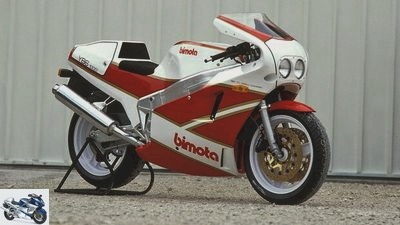
fac, Frank Herzog, Ralf Schneider, Achim Hartmann, MOTORRAD-Archiv, Yamaha, Reinhold Kraft
Bimota YB6 1000: The predecessor of the YB8 appeared in 1988 with the first Yamaha FZR 1000 engine (986 cm³), but the look is still very much based on the superbike machine.
Predecessor of the YB8 with the first Yamaha FZR 1000 engine (986 cm³), still without the EXUP system in the exhaust. Chassis adapted from the 750 YB4, optically still very much based on the superbike machine. The skin-tight plastic dress was laminated by expensive manual labor and is not easy to dismantle.
Bimota Tuatara (1989)
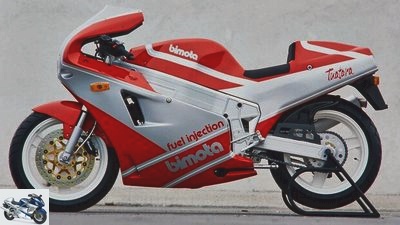
fac, Frank Herzog, Ralf Schneider, Achim Hartmann, MOTORRAD-Archiv, Yamaha, Reinhold Kraft
Bimota Tuatara: A noble version, built only 60 times, has been released since 1989. Anyone who owns one of the rare pieces should never sell it.
Noble version built only 60 times. With injection, high-quality spring elements from Marzocchi and electronic display. The explosive power delivery was difficult to control, the chassis almost at racing level. Anyone who owns one of the rare pieces should never sell it.
Bimota YB10 Dieci (1991)
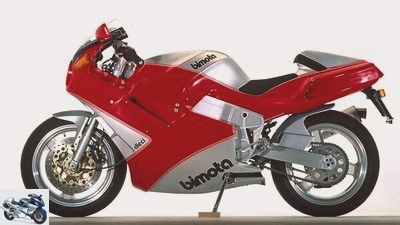
fac, Frank Herzog, Ralf Schneider, Achim Hartmann, MOTORRAD-Archiv, Yamaha, Reinhold Kraft
Bimota YB10 Dieci: Visually significantly redesigned model with a much more comfortable seating position and improved wind protection. By 1994, 224 copies had been built.
Visually significantly redesigned model with a significantly more comfortable seating position and improved wind protection. Technically similar to the YB8 models with the better tuned Yamaha FZR 1000 EXUP engine (1002 cm³). The spring elements were taken over from the Tuatara. By 1994, 224 copies had been built.
Bimota YB8 Evoluzione (1993)
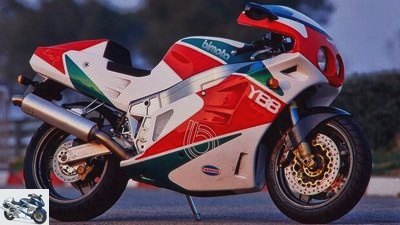
fac, Frank Herzog, Ralf Schneider, Achim Hartmann, MOTORRAD-Archiv, Yamaha, Reinhold Kraft
Bimota YB8 Evoluzione: In 1993 came the slightly revised version of the YB8 with injection and another change in optics. A nominal 164 hp and probably the best Bimota for everyday use. 169 copies were built.
Slightly revised version of the YB8 with injection and another change in optics. A nominal 164 hp and probably the best Bimota for everyday use. Significantly improved spring elements from Paioli, more comfortable seating position, best workmanship. 169 copies were built.
Bimota YB11 (1996)
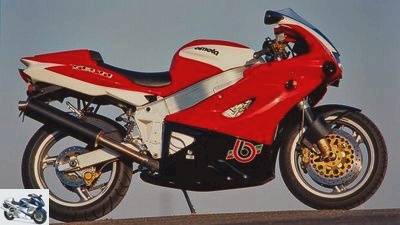
fac, Frank Herzog, Ralf Schneider, Achim Hartmann, MOTORRAD-Archiv, Yamaha, Reinhold Kraft
Bimota YB11: In 1996, the last 650 version of the Yamaha Bimotas came with the Thunderace’s 145 hp engine. Chassis still based on the YB6. Improved seating position, good workmanship, dry weight 183 kilograms.
Last, 650 times built version of the Yamaha Bimotas with the 145 HP Thunderace engine. Chassis still based on the YB6. Improved seating position, good workmanship, dry weight 183 kilograms. Again significantly changed optics with Yamaha headlights. Spring elements from Paioli.
Market situation
Even in earlier times, the expensive Italian treasures were rarely seen. The aluminum frame Yamaha Bimotas with 1000 engines, which have only been built 2,105 times, are very rarely offered, and when they are, it is usually not in optimal condition. A detailed inspection with the search for possible fall damage and a credible history are therefore a must.
The carburettor versions are best available. The injectors were often rather capricious when they were new. Recommendation: look out for a well-preserved YB8. The carburettors can often be overhauled with original Mikunit parts, the electronics are not changed much. The Marzocchi spring elements work with air support. Here you have to check whether the air is being held, also on the shock absorber. The best way to adjust the pressure is to use a special air pump for mountain bike struts.
The digital displays are very flawed, but were rarely installed. Check any carbon parts for cracks, here Bimota was often very brave in the dimensioning. The side stand springs also tend to break, also check. Basically, it is better to spend a little more, from 8,000 euros it becomes serious.
technology
The chassis and engine work together optimally on the Bimota YB8. The cylinder bank of the Yamaha FZR 1000 engine, which is inclined forwards, can be easily encompassed by the simply drawn bimoto frame. The almost vertically arranged carburettors are optimally ventilated from the air filter box protruding to the front. The tank is located behind it with a favorable center of gravity and is compact.
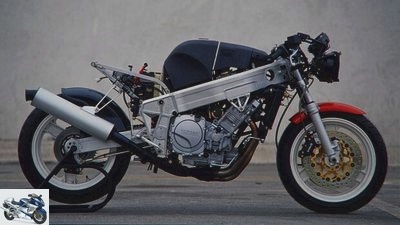
fac, Frank Herzog, Ralf Schneider, Achim Hartmann, MOTORRAD-Archiv, Yamaha, Reinhold Kraft
The chassis and engine work together optimally on the Bimota YB8.
The main frame consists of semi-finished products for aircraft construction and a special, high-strength aluminum alloy. Powerful cross members ensure a stable steering head. The plates of the swing arm bearings were artfully milled from solid and finely machined. Just like the triple clamps and the engine and exhaust mounts, by the way. Sure, you would build a more expansive swingarm today, back then there weren’t such great demands on the rear wheel guidance. Which was perhaps also due to the comparatively humane peak performance of measured 128 PS.
Wheels, brakes and suspension elements came from the renowned manufacturers Marchesini, Brembo and Marzocchi. Above all, the Marzocchi elements overwhelmed the hobby driver because of their meticulously adjustable air support. There should be at least 6 bar in the shock absorber and 2.5 in the fork.
Bimota YB8 Furano
It was an ice cold day, sometime towards the end of 1991, when Bimota importer Reinhold Kraft called me: “You, I have the first Furano here, you have to look at that thing. Made great!” Reinhold was ecstatic and I was in our editorial Opel. Photographer Frank and leather suit invited to Leutkirch. The Furano beamed at me in the deep sunlight, it was extremely well made. Bimota workshop man Buffi let the engine warm up, the injected Yamaha foursome barked hoarsely from the rather loud muffler. Palpitations! The Bimotese claimed 164 hp for their top model, and I was now the first journalist in the world who was allowed to drive this rocket. What an experience. The machine hung incredibly directly on the gas, steered itself as easily as a feather and had steam in all positions. High-sheen rims, carbon-fiber windows in the cladding, the best paint quality, this beautifully crafted frame – I was blown away. For me the best Bimota ever. Good for those who own one.
Reinhold Kraft on Bimota YB8
PS: Reinhold, you were a Honda dealer for a long time and at some point a Bimota importer. How did that happen?
Power: That must have been sometime in 1986, when the import was advertised. I was an Egli importer for a few years. And at some point that didn’t really go any further, because the central tubular frame no longer matched with the new Japanese engines because of the vertical intake ducts. And then I just applied for it. Then a polite Italian gentleman called me and we made a contract. I felt really honored. Bimota was the ultimate for me back then. The DB1, the first fully faired motorcycle, was a sensation. I felt really big there, progressive. Working directly with such a manufacturer made me very happy.
PS: And in racing things went pretty well for Bimota in those times, right??
Power: Oh yeah! We already had winning drivers in the TT Formula 1 with Virginio Ferrari and Davide Tardozzi. Then, at the Superbike World Championship, Tardozzi won both races in Hockenheim. I was proud like Oscar.
PS: But not only on the slopes, Bimota was also a big number in the paddock back then.
Power: Yes, that’s right. I was actually the first to turn it into a big event. My brother Lothar played in a jazz band, so we had music. There was food and drink, I invited the Bimota Club and our customers, that was something. Today something like that is normal in the paddock, back then I was definitely one of the first.
PS: Regarding the YB8: What do you think of when you think of this groundbreaking Bimota?
Power: The motorcycle was a revelation for us. Engineer Federico Martini built this beautiful frame for the superbikes and then fitted the 1000cc Yamaha engine in. In addition, there were hardly any fully faired motorcycles at that time. Except for the DB1 and the Ducati Paso, there was hardly anything in the sporting field. When we then had the first YB6, which was actually almost identical to the later YB8, we felt that a great time had dawned.
PS: Was that actually the best time at Bimota?
Power: Actually already. Even when Massimo Tamburini was there, the philosophy was: “From the slopes to the street.” Martini had realized exactly that with the Yamaha Bimotas. They rode with the front runners or even won against the world’s elite, and the customer could more or less buy such a road-legal motorcycle. That was a great time, especially since Mr. Morri, the boss at the time, was still on board. I had a good relationship with him. In general, an importer was something completely different back then. We were actually part of Bimota. We were there almost everywhere and also respected. Every year we went to the plant with our customers, it was a large, grown community.
PS: And the YB8 also sold well, right??
Power: Yes, together with the different versions such as the Furano and later the Dieci, we were very satisfied. It was still a hand-made small series that was manageable. By and large, the YB8 models also ran reliably. You always have to make small compromises with handmade motorcycles. But we had that under control.
PS: At some point your business got a little more difficult, we remember.
Power: When the Suzuki Bimotas came, it actually got more difficult. Demand for the SB6 was so high that the plant had to look for completely new suppliers. And they often did not deliver the quality that makes a Bimota. In addition, these Bimotas were also sold through the Suzuki dealer network. And of course these dealers did not have the time and love to take care of these handmade machines. We bled a lot there. I had to convert some machines because the workshops couldn’t get the problems under control. We then drove across Germany in the van and repaired the machines. The demand was just too great, and Bimota couldn’t meet it. In addition, a gray importer had opened up to offer Bimotas cheaper. We stopped then in 1997.
PS: Are you still in contact with the Bimota owners today?
Power: There were always contacts with the various Bimota owners. I was often asked for advice. Sure, our time was the most successful in the company’s history. There were also the really good Ducati Bimotas, for example the DB2 …
PS: And the Tesi.
Power: Oh yes, the Tesi! That was a laborious thing. As an importer, you had to spend some time getting these machines to work properly. But when I look at them today, these street fighters that were still being built back then, they were really great. We were just a little early. The YB9 with the Yamaha FZR 600 engine also sold well.
PS: If you had to choose the best Bimota today after all these years, which one would you choose?
Power: Good question. The DB2 and the Furano. The DB2 drives beautifully and the Furano was the best motorcycle in the world in its day.
Related articles
-
Comparison test Aprilia RSV 1000 R Factory, Bimota DB7, Ducati 1098 S
K motorcycles Comparison test Aprilia RSV 1000 R Factory, Bimota DB7, Ducati 1098 S Comparison test Aprilia RSV 1000 R Factory, Bimota DB7, Ducati 1098 S…
-
Motorcycle production at Bimota
Jahn counselor traffic & business Motorcycle production at Bimota This is how one of the smallest manufacturers in the world produces Motorcycle…
-
motorcycles Test Voxan V 1000 Roadster Test Voxan V 1000 Roadster The fresh French Voxan, that sounds a bit like toothpaste. Or for an aggressive…
-
Comparison test between Suzuki DL 1000 V-Strom and Yamaha TDM 900
Artist motorcycles Comparison test between Suzuki DL 1000 V-Strom and Yamaha TDM 900 Comparison test between Suzuki DL 1000 V-Strom and Yamaha TDM 900…
-
Second-hand advice: Yamaha FZS 1000 Fazer, FZ1 Fazer, FZ1
archive counselor Used purchase Second-hand advice: Yamaha FZS 1000 Fazer, FZ1 Fazer, FZ1 Second-hand advice: Yamaha FZS 1000 Fazer, FZ1 Fazer, FZ1 Buy…
-
BMW S 1000 RR used buying tips model year 2010 to 2018
13th pictures 1/13 With the double-R, BMW set new standards among super sports cars. It will be new in 2019 – a great opportunity to buy a used vehicle!…
-
motorcycles Impression Uno TL 1000 S Impression Uno TL 1000 S Werner’s Fifth Werner Koch has been building motorcycles for as long as he can remember….
-
Laverda Bimota – merger of two motorcycles
Fred Siemer 17th pictures Fred Siemer 1/17 An East Frisian collector appreciates the three-cylinder Laverda just as much as special European chassis….
-
Pit lane: 1000 kilometers from Hockenheim
Jahn Sports & scene Motorsport Pit lane: 1000 kilometers from Hockenheim Pit lane: 1000 kilometers from Hockenheim All beginning … Content of The…
-
Comparison test Honda CBF 1000 against Suzuki Bandit 1250 S
Rossen Gargolov motorcycles Comparison test Honda CBF 1000 against Suzuki Bandit 1250 S Comparison test Honda CBF 1000 against Suzuki Bandit 1250 S We…